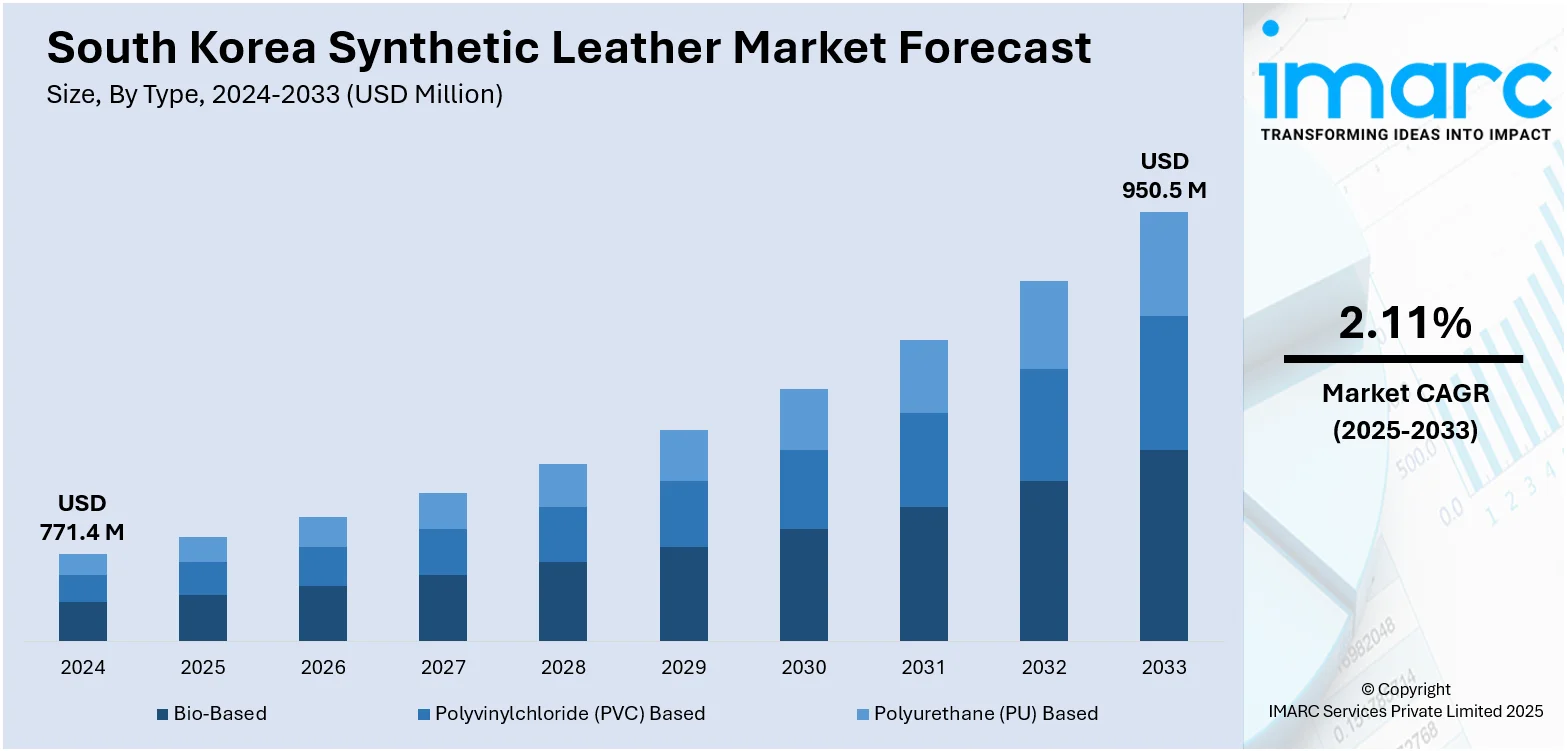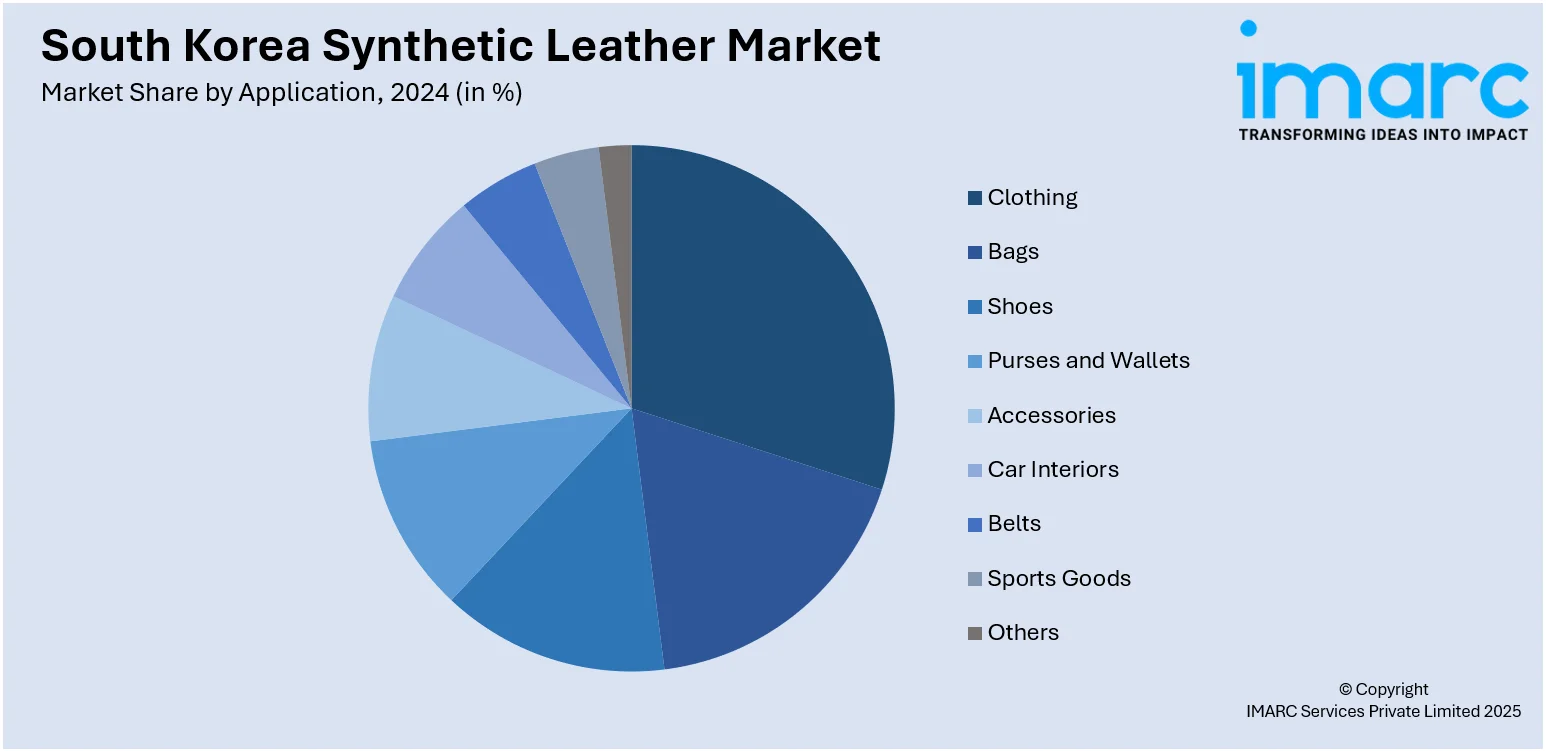
South Korea Synthetic Leather Market Size, Share, Trends and Forecast by Type, Application, End Use Industry, and Region, 2025-2033
South Korea Synthetic Leather Market Overview:
The South Korea synthetic leather market size reached USD 771.4 Million in 2024. Looking forward, the market is projected to reach USD 950.5 Million by 2033, exhibiting a growth rate (CAGR) of 2.11% during 2025-2033. The market is majorly driven by various sustainable innovations in bio-based and waterborne synthetic leather suited for regulatory compliance and ethical consumption. Korea’s fashion and accessories industries continue to demand customizable, affordable materials for trend-responsive collections. Widespread application in automotive interiors, aligned with OEM sustainability goals, is further augmenting the South Korea synthetic leather market share.
|
Report Attribute
|
Key Statistics
|
|---|---|
|
Base Year
|
2024
|
|
Forecast Years
|
2025-2033
|
|
Historical Years
|
2019-2024
|
| Market Size in 2024 | USD 771.4 Million |
| Market Forecast in 2033 | USD 950.5 Million |
| Market Growth Rate 2025-2033 | 2.11% |
South Korea Synthetic Leather Market Trends:
Eco-Friendly Manufacturing and Material Innovation
South Korea’s synthetic leather market is benefiting from strong demand for environmentally responsible alternatives to animal-based leather. With global attention on sustainability and animal welfare, Korean manufacturers are focusing on solvent-free, water-based, and bio-based polyurethane (PU) and polyvinyl chloride (PVC) products. The country’s advanced chemical industry has enabled the production of high-performance synthetic leather that mimics the texture and durability of natural leather, while offering reduced emissions and recyclability. Government regulations and ESG (Environmental, Social, Governance) benchmarks are encouraging manufacturers to replace hazardous solvents with green chemistry and adopt closed-loop production systems. Korean research institutions and start-ups are developing plant-based resins and cellulose blends to meet the growing demand from both local and international brands for biodegradable, non-toxic options. This innovation is particularly relevant in consumer electronics, fashion, and upholstery segments where sustainability credentials influence buyer decisions. The increasing focus on circular design and material reusability positions synthetic leather as a viable alternative across industries. South Korea synthetic leather market growth is increasingly driven by the convergence of sustainable manufacturing mandates, performance improvements, and global export opportunities.

To get more information on this market, Request Sample
Rising Demand in Fashion, Footwear, and Accessories
The South Korean fashion industry, known for its fast-paced trends and high consumer awareness, is significantly contributing to synthetic leather demand. Designers and fashion houses prefer synthetic alternatives for handbags, footwear, jackets, and wallets due to their flexibility, affordability, and wide aesthetic adaptability. The material’s ability to accommodate diverse colors, textures, and finishes allows for continuous experimentation in collections, which aligns with South Korea’s trend-driven consumer base. Leading domestic brands and e-commerce retailers have also embraced synthetic leather in vegan fashion lines targeting eco-conscious millennials and Gen Z consumers. International luxury and streetwear brands operating in South Korea use high-grade PU leather to cater to sustainability-conscious buyers without compromising on appearance or quality. Additionally, synthetic leather’s lightweight nature and ease of handling make it an ideal choice for seasonal collections and limited-edition accessories. As social influencers and K-pop celebrities endorse cruelty-free fashion, public acceptance of synthetic leather has become mainstream. The growing intersection of ethical consumption, affordability, and high design value continues to position synthetic leather as a material of choice in Korea’s fashion-forward market.
Automotive Sector Adoption and Interior Customization
South Korea’s strong automotive manufacturing base, led by Hyundai, Kia, and related suppliers, has made vehicle interiors a major application area for synthetic leather. With rising consumer expectations for comfort, hygiene, and aesthetics, automakers are increasingly incorporating synthetic leather into car seats, dashboards, and steering wheels. Unlike natural leather, synthetic variants offer uniform texture, stain resistance, and lower production costs, making them suitable for both premium and mid-range vehicle segments. In electric vehicles (EVs), where sustainability and futuristic design are critical, synthetic leather aligns with the ethos of next-generation interiors. The material also supports customization in color, texture, and embossing, catering to both domestic and export markets. Suppliers are developing flame-retardant, UV-resistant, and antimicrobial finishes to meet performance and regulatory standards. As in-vehicle experience becomes a branding tool, especially in high-end and shared mobility vehicles, the appeal of synthetic leather extends to noise reduction and luxury enhancement. Automotive OEMs are also integrating synthetic leather into marketing narratives focused on environmental responsibility and comfort. This consistent demand from the auto sector provides long-term stability to the synthetic leather supply chain in South Korea.
South Korea Synthetic Leather Market Segmentation:
IMARC Group provides an analysis of the key trends in each segment of the market, along with forecasts at the country and regional levels for 2025-2033. Our report has categorized the market based on type, application, and end use industry.
Type Insights:
- Bio-Based
- Polyvinylchloride (PVC) Based
- Polyurethane (PU) Based
The report has provided a detailed breakup and analysis of the market based on the type. This includes bio-based, polyvinylchloride (PVC) based, and polyurethane (PU) based.
Application Insights:

- Clothing
- Bags
- Shoes
- Purses and Wallets
- Accessories
- Car Interiors
- Belts
- Sports Goods
- Others
The report has provided a detailed breakup and analysis of the market based on the application. This includes clothing, bags, shoes, purses and wallets, accessories, car interiors, belts, sports goods, and others.
End Use Industry Insights:
- Footwear
- Furniture
- Automotive
- Textile
- Sports
- Electronics
- Others
The report has provided a detailed breakup and analysis of the market based on the end use industry. This includes footwear, furniture, automotive, textile, sports, electronics, and others.
Regional Insights:
- Seoul Capital Area
- Yeongnam (Southeastern Region)
- Honam (Southwestern Region)
- Hoseo (Central Region)
- Others
The report has also provided a comprehensive analysis of all major regional markets. This includes Seoul Capital Area, Yeongnam (Southeastern Region), Honam (Southwestern Region), Hoseo (Central Region), and others.
Competitive Landscape:
The market research report has also provided a comprehensive analysis of the competitive landscape. Competitive analysis such as market structure, key player positioning, top winning strategies, competitive dashboard, and company evaluation quadrant has been covered in the report. Also, detailed profiles of all major companies have been provided.
South Korea Synthetic Leather Market News:
- On June 17, 2025, Kumho Mitsui Chemicals Inc. (KMCI) began operations at its new chlor-alkali plant in Yeosu, South Korea, which will produce 60,000 tons of chlorine annually to strengthen local supply for Methylene Diphenyl Diisocyanate (MDI) production. The plant supports domestic manufacturing of spandex, TPU, synthetic leather, footwear, paints, and elastomers.
South Korea Synthetic Leather Market Report Coverage:
| Report Features | Details |
|---|---|
| Base Year of the Analysis | 2024 |
| Historical Period | 2019-2024 |
| Forecast Period | 2025-2033 |
| Units | Million USD |
| Scope of the Report |
Exploration of Historical Trends and Market Outlook, Industry Catalysts and Challenges, Segment-Wise Historical and Future Market Assessment:
|
| Types Covered | Bio-Based, Polyvinylchloride (PVC) Based, Polyurethane (PU) Based |
| Applications Covered | Clothing, Bags, Shoes, Purses and Wallets, Accessories, Car Interiors, Belts, Sports Goods, Others |
| End Use Industries Covered | Footwear, Furniture, Automotive, Textile, Sports, Electronics, Others |
| Regions Covered | Seoul Capital Area, Yeongnam (Southeastern Region), Honam (Southwestern Region), Hoseo (Central Region), Others |
| Customization Scope | 10% Free Customization |
| Post-Sale Analyst Support | 10-12 Weeks |
| Delivery Format | PDF and Excel through Email (We can also provide the editable version of the report in PPT/Word format on special request) |
Key Questions Answered in This Report:
- How has the South Korea synthetic leather market performed so far and how will it perform in the coming years?
- What is the breakup of the South Korea synthetic leather market on the basis of type?
- What is the breakup of the South Korea synthetic leather market on the basis of application?
- What is the breakup of the South Korea synthetic leather market on the basis of end use industry?
- What is the breakup of the South Korea synthetic leather market on the basis of region?
- What are the various stages in the value chain of the South Korea synthetic leather market?
- What are the key driving factors and challenges in the South Korea synthetic leather market?
- What is the structure of the South Korea synthetic leather market and who are the key players?
- What is the degree of competition in the South Korea synthetic leather market?
Key Benefits for Stakeholders:
- IMARC’s industry report offers a comprehensive quantitative analysis of various market segments, historical and current market trends, market forecasts, and dynamics of the South Korea synthetic leather market from 2019-2033.
- The research report provides the latest information on the market drivers, challenges, and opportunities in the South Korea synthetic leather market.
- Porter's five forces analysis assist stakeholders in assessing the impact of new entrants, competitive rivalry, supplier power, buyer power, and the threat of substitution. It helps stakeholders to analyze the level of competition within the South Korea synthetic leather industry and its attractiveness.
- Competitive landscape allows stakeholders to understand their competitive environment and provides an insight into the current positions of key players in the market.
Need more help?
- Speak to our experienced analysts for insights on the current market scenarios.
- Include additional segments and countries to customize the report as per your requirement.
- Gain an unparalleled competitive advantage in your domain by understanding how to utilize the report and positively impacting your operations and revenue.
- For further assistance, please connect with our analysts.
 Request Customization
Request Customization
 Speak to an Analyst
Speak to an Analyst
 Request Brochure
Request Brochure
 Inquire Before Buying
Inquire Before Buying




.webp)




.webp)












